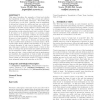490 search results - page 77 / 98 » Social Influence Models Based on Starbucks Networks |
113
click to vote
AAAI
1996
15 years 1 months ago
1996
We present a connectionist architecture that supports almost instantaneous deductive and abductive reasoning. The deduction algorithm responds in few steps for single rule queries...
139
click to vote
KDD
2012
ACM
13 years 2 months ago
2012
ACM
Many data are modeled as tensors, or multi dimensional arrays. Examples include the predicates (subject, verb, object) in knowledge bases, hyperlinks and anchor texts in the Web g...
120
Voted
ATAL
2010
Springer
15 years 1 months ago
2010
Springer
We propose Path Disruption Games (PDGs), which consider collaboration between agents attempting stop an adversary from travelling from a source node to a target node in a graph. P...
130
Voted
ACMICEC
2006
ACM
15 years 6 months ago
2006
ACM
This paper formalizes the semantics of trust and studies the transitivity of trust. On the Web, people and software agents have to interact with “strangers”. This makes trust ...
INFOCOM
2009
IEEE
15 years 7 months ago
2009
IEEE
Abstract— Although direct reciprocity (Tit-for-Tat) contribution systems have been successful in reducing freeloading in peerto-peer overlays, it has been shown that, unless the ...


